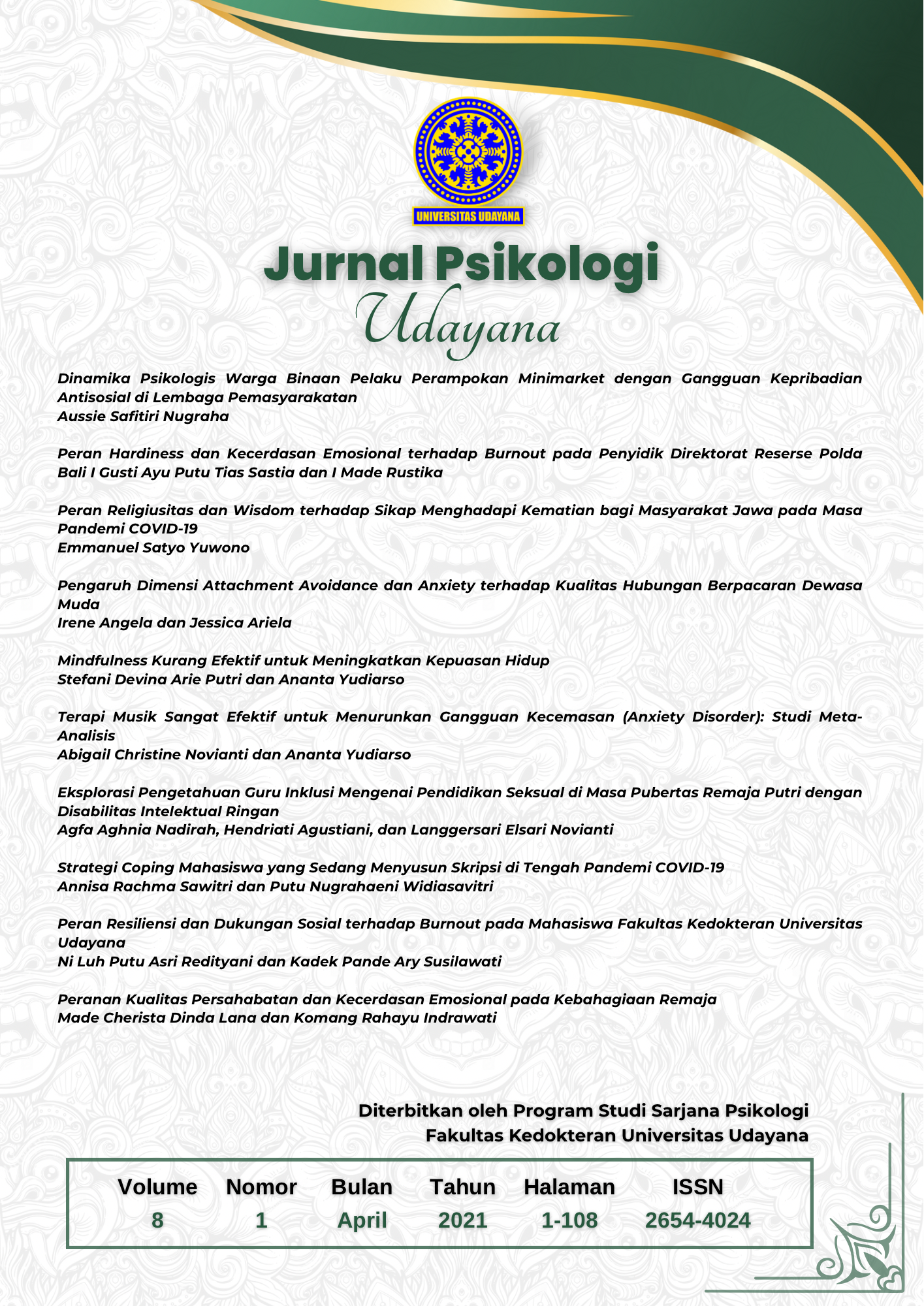Peranan kualitas persahabatan dan kecerdasan emosional pada kebahagiaan remaja
Abstract
Remaja mengalami berbagai tantangan dalam menjalani fase perkembangannya sebagai seorang remaja, dengan adanya perubahan pada aspek biologis, kognitif, dan sosio-emosionalnya. Remaja yang memiliki kesehatan mental yang baik dapat menghadapi masa remaja dengan adaptif, dimana kesehatan mental merupakan anteseden dari kebahagiaan. Kebahagiaan yang dimiliki remaja dapat membantu remaja dalam melewati masa transisinya ini. Studi pendahuluan yang dilaksanakan oleh peneliti menemukan bahwa kebahagiaan remaja dapat berasal dari hubungan dengan orang terdekat seperti sahabat, keluarga, dan pacar serta remaja membutuhkan regulasi emosi yang baik untuk menstimulasi munculnya emosi positif. Penelitian ini ialah penelitian kuantitatif guna melihat peran kualitas persahabatan dan kecerdasan emosional terhadap kebahagiaan remaja di Indonesia. Subjek penelitian sebanyak 265 remaja berusia 12-30 tahun yang dipilih secara acak melalui media online (google form). Alat ukur penelitian ini meliputi skala kualitas persahabatan dengan reliabilitas 0,918, skala kecerdasan emosional dengan reliabilitas 0,859 dan skala kebahagiaan dengan reliabilitas 0,925. Hasil uji regresi berganda menunjukkan bahwa kualitas persahabatan dan kecerdasan emosional secara bersamaan memiliki peranan sebesar 50,9% terhadap kebahagiaan remaja. Penelitian ini juga mngindikasikan remaja pada usia 18-20 tahun memiliki tingkat kualitas persahabatan yang lebih tinggi daripada remaja pada usia 12-15 tahun.
Downloads
References
Almquist, Y. B., Östberg, V., Rostila, M., Edling, C., & Rydgren, J. (2013). Friendship network characteristics and psychological well-being in late adolescence: Exploring differences by gender and gender composition. Scandinavian Journal of Public Health, 42(2), 146–154. https://doi.org/10.1177/1403494813510793
Amati, V., Meggiolaro, S., Rivellini, G., & Zaccarin, S. (2018). Social relations and life satisfaction: the role of friends. Genus, 74(1), 7. https://doi.org/10.1186/s41118-018-0032-z
Azwar, S. (2013). Dasar-dasar psikometri. Pustaka Belajar.
Bar-On, R. (1997). Development of the Bar-On EQ-I: A measurement of emotional and social intelligence. Paper Presented at the 105th Annual Convention of the American Psychological Association.
Broadbent, E., Gougoulis, J., Lui, N., Pota, V., & Simons, J. (2017). Generation Z: Global citizenship survey. The Varkey Foundation.
Bukowski, W. M., Hoza, B., & M, B. (1994). Measuring friendship quality during pre- and early adolescence: The development and psychometric properties of the friendship qualities scale. Journal of Soical and Personal Relationship, 11(3), 471–484. https://doi.org/10.1177/0265407594113011
Chaplin, L. N., Bastos, W., & Lowrey, T. M. (2010). Beyond brands: Happy adolescents see the good in people. The Journal of Positive Psychology, 5(5), 342–354.
Dariyo, A. (2017). Hubungan Antara Persahabatan dan Kecerdasan Emosi dengan Kepuasan Hidup Remaja. Journal Psikogenesis, 5(2), 168. https://doi.org/10.24854/jps.v5i2.505
Demir, M., Orthel-Clark, H., Özdemir, M., & Özdemir, S. B. (2015). Friendship and happiness among young adults. Springer Science+Business Media Dordrecht. https://doi.org/10.1007/978-94-017-9603-3_7
Djang, L. J. (2011). Early adolescent development: A content analysis of adolescent development textbooks. Theses and Dissertations Paper, 1178.
Eid, M., & Larsen, R. J. (2008). The science of subjective well-being. Guilford Press.
Erdley, C. A., & Day, H. J. (2017). Friendship in childhood and adolescence. In M. Hojjat & A. Moyer (Eds.), The psychology of friendship (pp. 3–19). Oxford University Press.
Escoda, N. P., & Alegre, A. (2016). Does Emotional Intelligence Moderate the Relationship between Satisfaction in Specific Domains and Life Satisfaction? International Journal of Psychology and Psychological Therapy, 16(2), 131–140.
Febrieta, D. (2014). Persahabatan dan kecerdasan emosi sebagai prediktor kebahagiaan pada dewasa muda [Magister Thesis, Program Magister Psikologi Fakultas Psikologi Universitas Gadjah Mada Yogyakarta]. https://doi.org/10.13140/RG.2.2.11246.15682
Field, A. (2009). Discovering statistics using SPSS (3rd ed.). SAGE Publisher.
Goleman, D. (2017). Kecerdasan emosional: Mengapa EI lebih penting daripada IQ. PT. Gramedia Pustaka Utama.
Grunebaum, J. O. (2003). Friendship: Liberty, equality, and utility. State University of New York Press.
Hartup, W. W., & Stevens, N. (1997). Friendship and adaption in the life course. Psychological Bulletin, 121(3), 355–370. https://doi.org/10.1037/0033-2909.121.3.355
Hatfield, E., Cacioppo, J. T., & Rapson, R. L. (1993). Emotional contagion. Current Directions in Psychological Science, 2(3), 96–99.
Hills, P., & Argyle, M. (2002). The oxford happiness questionnaire: a compact scale for the measurement of psycholoical well-being. Personality and Individual Differences, 33, 1073–1082.
Hojjad, M., & Moyer, A. (2017). The psychology of friendship. Oxford University.
Keefer, K. V, Holden, R. R., & Parker, J. D. A. (2013). Longitudinal assessment of trait emotional intelligence: Measurement invariance and construct continuity from late childhood to adolescence. Psychological Assessment, 25(4), 1255–1272.
Khosla, M., & Dokania, V. (2010). Does happiness promote emotional intelligence? Journal of the Indian Academy of Applied Psychology, 36(1), 45–54.
King, L. A. (2014). Psikologi umum: Sebuah pandangan apresiatif. Salemba Humanika.
Parkinson, B. (2011). Interpersonal emotion transfer: Contagion and social appraisal. Social and Personality Psychology Compass, 5(7), 428–439. https://doi.org/10.1111/j.1751-9004.2011.00365.x.
Primasari, A., & Yuniarti, K. W. (2012). What make teenagers happy? An exploratory study using indigenous psychology approach. International Journal of Research Studies in Psychology, 1(2), 53–61.
Renanita, T., Hakim, M. A., Yuniarti, K. W., & Kim, U. (2012). Vulnerable factors of sadness among adolescents in Indonesia: an exploratory indigenous research. Humanities, 9(1).
Sajjadian, P., Kalantari, M., Abedi, M. R., & Nilforooshan, P. (2016). Predictive model of happiness on the basis of positive psychology constructs. Review of European Studies, 8(4).
Sandjojo, C. T. (2017). Hubungan antara kualitas persahabatan dengan kebahagiaan pada remaja urban. Jurnal Ilmiah Mahasiswa Universitas Surabaya, 6(2).
Santrock, J. W. (2007). Remaja. Erlangga.
Selvam, T. (2017). Function of peer group in adolescence life. International Journal of Scientific Research and Review, 6(11).
Shaffer, D. R., & Kipp, K. (2010). developmental psychology childhood and adolesence (8th ed.). Wadsworth Publishing.
Steinberg, L., & Monahan, K. C. (2007). Age differences in resistance to peer influence. Developmental Psychology, 43, 1531–1543.
Suldo, S. M., & Huebner, E. S. (2006). Is extremely high life satisfaction during adolescence advantageous? Social Indicator Research, 78(2), 179–203.
The Varkey Foundation. (2017). Generation Z: Global citizenship survey: The Varkey Foundation. https://www.varkeyfoundation.org/media/4487/global-young-people-report-single-pages-new.pdf
Tomé, G., Matos, M., Simões, C., Diniz, J. A., & Camacho, I. (2012). How can peer group influence the behavior of adolescents: explanatory model. Global Journal of Health Science, 4(2), 26–35. https://doi.org/10.5539/gjhs.v4n2p26
Van Cleemput, K. (2012). Friendship type, clique formation and the everyday use of communication technologies in a peer group. Information, Communication, & Society, 15(8), 1258–1277. https://doi.org/10.1080/1369118x.2011.60632

This work is licensed under a Creative Commons Attribution-ShareAlike 4.0 International License.
Authors who publish with this journal agree to the following terms:
- Authors retain copyright and grant the journal right of first publication with the work simultaneously licensed under a Creative Commons Attribution-ShareAlike 4.0 International License that allows others to share the work with an acknowledgement of the works authorship and initial publication in this journal.
- Authors are able to enter into separate, additional contractual arrangements for the non-exclusive distribution of the journals published version of the work (e.g., post it to an institutional repository or publish it in a book), with an acknowledgement of its initial publication in this journal.
- Authors are permitted and encouraged to post their work online (e.g., in institutional repositories or on their website) prior to and during the submission process, as it can lead to productive exchanges, as well as earlier and greater citation of published work (See The Effect of Open Access).













